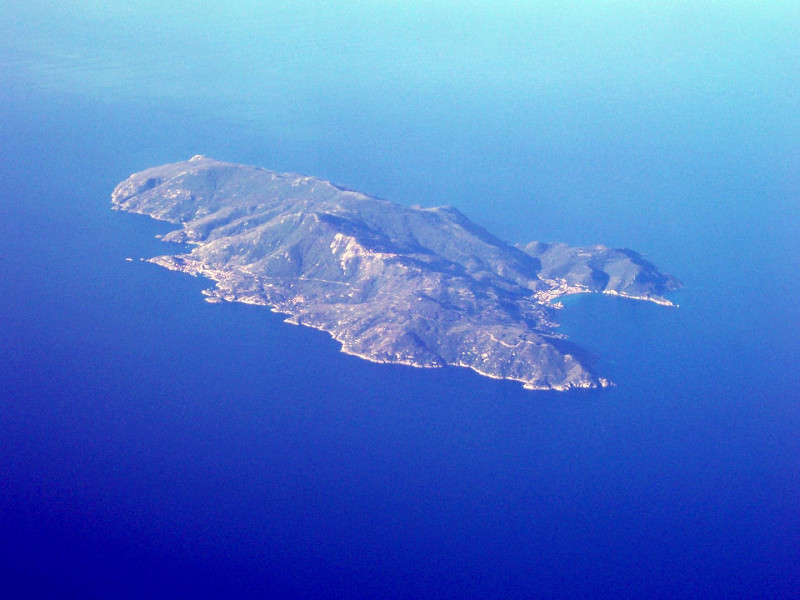Isola del Giglio
Isola del Giglio (Italian pronunciation: [ˈiːzola del ˈdʒiʎʎo]; English: Giglio Island) is an Italian island and comune situated in the Tyrrhenian Sea, off the coast of Tuscany, and is part of the Province of Grosseto. The island is one of seven that form the Tuscan Archipelago, lying within the Arcipelago Toscano National Park. Giglio means "lily" in Italian, and though the name would appear consistent with the insignia of Medici Florence, it derives from Aegilium, "Goat Island", a Latin transliteration of the Greek word for "little goat" (Ancient greek: Aigýllion, Αιγύλλιον). Geography The island is separated by a 16-kilometre (10 mi) stretch of sea from the nearest point of the mainland, the promontory of Monte Argentario. Mainly mountainous, it consists almost entirely of granite, culminating in the Poggio della Pagana, which rises to 496 metres (1,627 ft). Ninety percent of its surface is covered by Mediterranean vegetation, alternating with large pine forests and numerous vineyards which allow the production of the local "Ansonaco" wine. The coast is 27 kilometres (17 mi) long, made up of rocks, smooth cliffs and several bays: Arenella, Cannelle, Caldane and Campese, the biggest one with its small village of the same name. The municipality is composed of the islands of Giglio and Giannutri. Three principal settlements are located on the main island: Giglio Porto (G. Harbour) is located on the eastern coastal side and hosts the port. It is divided into the quarters of Chiesa, Moletto and Saraceno. Giglio Castello (G. Castle) is located upon a hill between the two other localities and is characterized by the majestic walls of a fortress. It is divided into the quarters of Casamatta, Centro, Cisterna and Rocca. Giglio Campese is located on the north-western coastal side and is a modern sea resort. History The modern island was formed probably 4.5 to 5 million years ago, and has been inhabited since the Stone Age. Later, it was probably an Etruscan military stronghold. Under the Roman dominion, Aegilium Insula or Igillia Insula it was an important base in the Tyrrhenian Sea, and was cited briefly by Julius Caesar in his De Bello Civili, by Pliny, by Pomponius Mela, and by the fifth-century AD poet Rutilius Claudius Namatianus, who celebrated Igilium's successful repulse of the Getae and safe harbor for Romans, in a time when Igilium's slopes were still wooded: Eminus Igilii silvosa cacumina mirorQuam fraudare nefas laudis honore suae.Wondering, Igilium's wooded heights I view Afar, and must not cheat them of the praise Due to their fame. In 805, the island was donated by Charlemagne to the abbey of the Tre Fontane in Rome, and was later successively a possession of the Aldobrandeschi, Pannocchieschi, Caetani, and Orsini families, and of the municipality of Perugia. In 1241, the Sicilian fleet of Emperor Frederick II destroyed a Genoese fleet. From 1264, Isola del Giglio was a Pisan dominion, from which it passed to the Medici family. It suffered several Saracen attacks, which ended only in 1799. On 14 June 1646, Grand Admiral Jean Armand de Maillé-Brézé was killed at the Battle of Orbetello, at sunset on his flag ship the Grand Saint Louis. Alongside its history, the island was always renowned for its mineral ore: many columns and buildings in Rome were built with the Gigliese granite. Main sights The island houses the remains of a Roman villa of Domitius Ahenobarbus (1st-2nd century AD), in the area of Giglio Porto (Giglio port). No traces of the once existing Temple of Diana can be seen now. The church of San Pietro Apostolo in Giglio Castello (Giglio castle) has an ivory crucifix attributed to the sculptor Giambologna. The island is also the site of an Etruscan shipwreck dating back to the early Iron age, c. 600 BC. The cargo of the ship included copper and lead ingots, iron spits, amphorae and a Corinthian helmet. Even a wooden writing tablet with stylus was preserved. The finds are almost completely lost now. Transportation Isola del Giglio is connected to Tuscany by ferries Toremar and Maregiglio ("sea lily"), departing from Porto Santo Stefano. Costa Concordia grounding incident In 2012, the island received prolonged international media attention, following the 13 January 2012 running aground of the cruise liner Costa Concordia, just off the island's shore. Most of the more than 4,200 passengers and crew were rescued and taken to the island, as well as to the mainland. At least 30 people died and 64 were injured, with 2 missing (as of 20 December 2012). The people of the island rushed to help, providing hot drinks and blankets, and many opened their homes to the victims. The arrival of 2,000 salvage workers invigorated life on the island, and many of the workers fraternised with the islanders. Some local girls left the island with their new partners. The ship removal work was started in 2013 and was completed towards the end of July 2014. Floatation devices were attached to right the ship and then raise it. It was subsequently towed to its final destination port of Genoa for dismantling procedures. In popular fiction In the 2007 romantic bestselling Italian novel Scusa ma ti chiamo amore by Federico Moccia, the couple end up living in a lighthouse on this island. Gallery Costa Concordia disaster References External links Isola del Giglio official website (Italian) Tourist and Visitor Information for Isola del Giglio www.giglioinfo.com Institute for Marine Biology located on Isola del Giglio Dive station and diving school located on Isola del Giglio Tourism in Isola del Giglio

